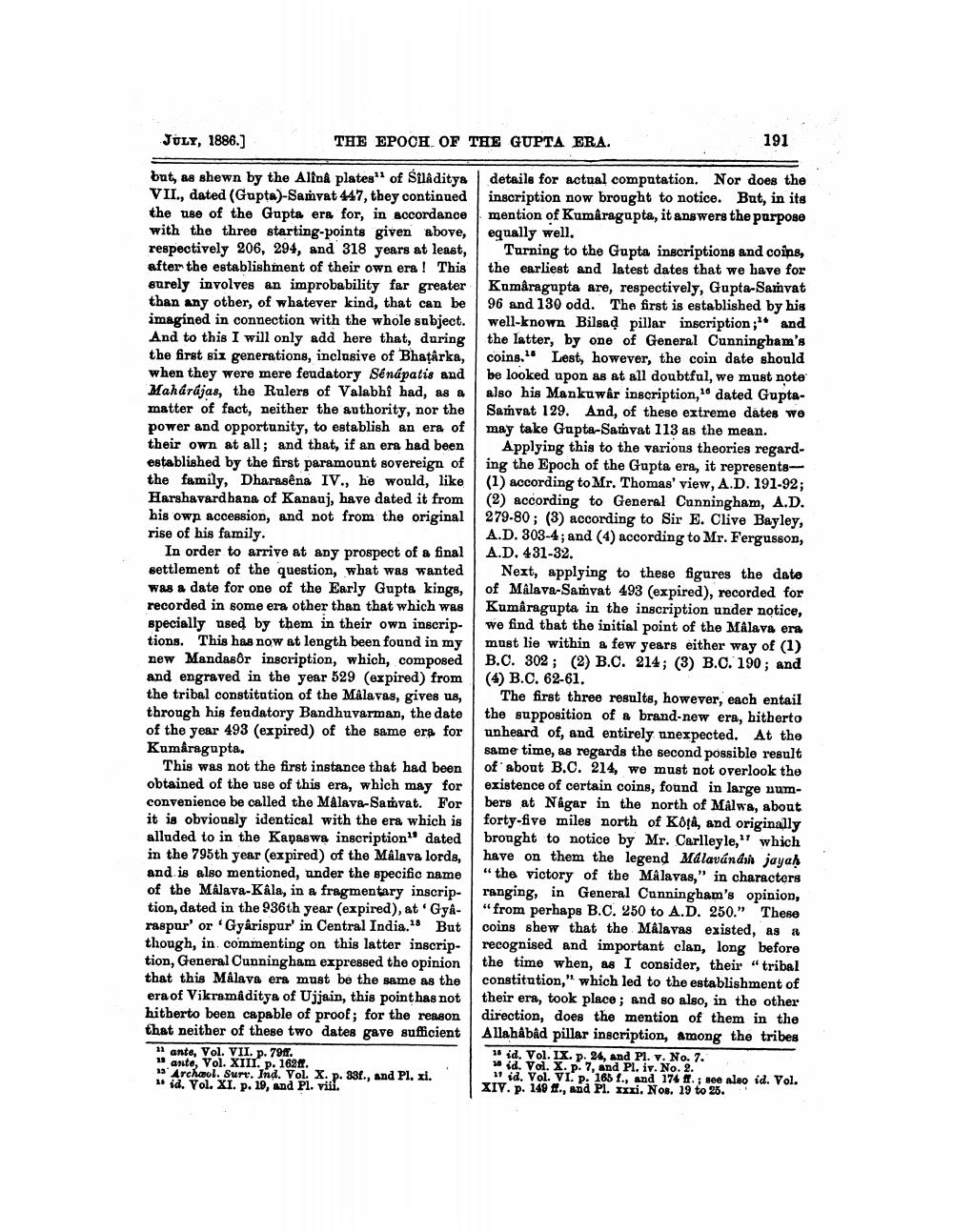________________
JÚLY, 1886.)
THE EPOCH OF THE GUPTA ERA.
191
but, as shewn by the Alinâ plates" of Siladitya | details for actual computation. Nor does the VII., dated (Gupta)-Samvat 447, they continued inscription now brought to notice. But, in its the use of the Gupta era for, in accordance mention of Kumâragupta, it answers the purpose with the three starting-points given above, equally well. respectively 206, 294, and 318 years at least, Turning to the Gupta inscriptions and coins, after the establishment of their own era! This the earliest and latest dates that we have for surely involves an improbability far greater Kumâragupta are, respectively, Gupta-Samvat than any other, of whatever kind, that can be 96 and 130 odd. The first is established by his imagined in connection with the whole subject. well-known Bilsad pillar inscription;" and And to this I will only add here that, during the latter, by one of General Cunningham's the first six generations, inclusive of Bhatarka, coins." Lest, however, the coin date should when they were mere feudatory Sénápatis and be looked upon as at all doubtful, we must note Maharājas, the Rulers of Valabhi had, as a also his Mankuwâr inscription, 18 dated Guptamatter of fact, neither the authority, nor the Samvat 129. And, of these extreme dates we power and opportunity, to establish an era of may take Gupta-Samvat 113 as the mean. their own at all; and that, if an era had been Applying this to the various theories regardestablished by the first paramount sovereign of ing the Epoch of the Gupta era, it representsthe family, Dharasêna IV., he would, like (1) according to Mr. Thomas' view, A.D. 191-92; Harshavardhana of Kanauj, have dated it from (2) according to General Cunningham, A.D. his own accession, and not from the original 279-80; (3) according to Sir E. Clive Bayley, rise of his family.
A.D. 303-4; and (4) according to Mr. Fergusson, In order to arrive at any prospect of a final A.D. 431-32. settlement of the question, what was wanted Next, applying to these figures the date was a date for one of the Early Gupta kings, of MÁlava-Samvat 493 (expired), recorded for recorded in some era other than that which was Kumaragupta in the inscription under notice, specially used by them in their own inscrip- we find that the initial point of the MAlava era tions. This has now at length been found in my must lie within a few years either way of (1) new Mandasör inscription, which, composed B.C. 302; (2) B.C. 214; (3) B.C. 190; and and engraved in the year 529 (expired) from (1) B.C. 62-61. the tribal constitation of the Malavas, gives us, The first three results, however, each entail through his fendatory Bandhuvarman, the date the supposition of a brand-new era, hitherto of the year 493 (expired) of the same era for unheard of, and entirely unexpected. At the Kumaragupta,
same time, as regards the second possible result This was not the first instance that had been of about B.C. 214, we must not overlook the obtained of the use of this era, which may for existence of certain coins, found in large numconvenience be called the Málava-Samvat. For bers at Nagar in the north of Malwa, about it is obviously identical with the era which is forty-five miles north of Kot, and originally alluded to in the Kapaswa inscription" dated brought to notice by Mr. Carlleyle," which in the 795th year (expired) of the Mâlava lords, have on them the legend Malavándri jayah and is also mentioned, under the specific name "the victory of the Malavas," in characters of the MAlava-Kála, in a fragmentary inscrip- ranging, in General Cunningham's opinion, tion, dated in the 936th year (expired), at Gya- "from perhaps B.C. 250 to A.D. 250." These raspur' or 'Gyárispur' in Central India. But coins shew that the Mâlavas existed, as a though, in commenting on this latter inscrip- recognised and important clan, long before tion, General Cunningham expressed the opinion the time when, as I consider, their "tribal that this Mâlava era must be the same as the constitution," which led to the establishment of era of Vikramaditya of Ujjain, this point has not their era, took place; and so also, in the other hitberto been capable of proof; for the reason direction, does the mention of them in the that neither of these two dates gave sufficient Allahâbâd pillar inscription, among the tribes 11 ante, Vol. VII. p. 791.
15 id. Vol. IX. p. 24, and Pl. v. No. 7. Wante, Vol. XIII. p. 1628.
20 id. Vol. X. p. 7, and Pl. iv. No. 2. » Archaol. Surt. Ind. Vol. X. p. 83., and Pl. xi.
11 id. Vol. VI. p. 165 f., and 174 1. ; see also id. Vol. u id. Vol. XI. p. 19, and Pl. viii.
XIV. p. 149 ft., and Pl. IIx. Nos. 19 to 25.




